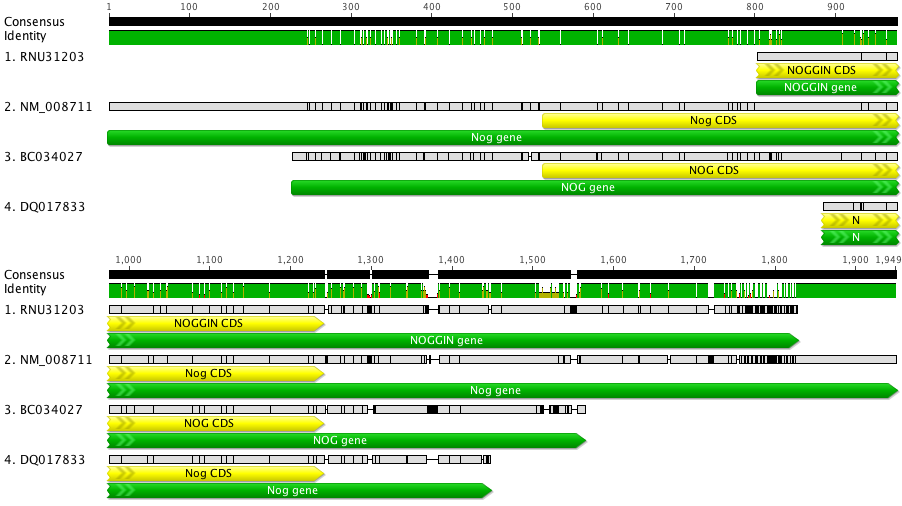Background[]
The NOG gene is located on chromosome 17 between base pairs 54,671,059 and 54,672,950 in humans. NOG encodes for the protein noggin. The noggin protein is believe to be pleotrophic and affect the proper development of joints, muscles, bones, neural tube fusion, and other tissues. The protein does this by regulating bone morphogenetic proteins (BMPs). BMPs belong to the transforming growth factor beta superfamily of proteins (TGF-beta). Noggin is an inhibitor of TGF-beta.
To regulate the BMPs, noggin binds to the BMP signaling proteins, which stops BMPs from attaching to their receptors and overall decreases BMP signaling. The BMPs are unable to bind to their receptors due to conformational changes induced by noggin. The regulation of BMPs using noggin and other inhibitors results in the polorizing of the organism.
A study conducted by MacMahon, Takada, Zimmerman, Fan, Harland, and MacMahon found the following concerning the loss of noggin:
"Loss of Noggin resulted in a recessive lethal phenotype at birth. Superficial examination revealed multiple defects including a failure of neural tube closure, broad club-shaped limbs, loss of caudal vertebrae, a shortened body axis, and retention of a small vestigial tail"
When mutations occur in the NOG gene, and not complete loss of function, medical difficulties such as tarsal-carpal coalition syndrome, Proximal symphalangism, Multiple synostosis syndrome 1 or Brachydactyly type B2 may occur.
Overview of Medical Conditions that can be caused due to Mutation:[]
- Carpal Coalition Syndrome: This syndrome is caused when a mutation in the NOG gene makes noggin protein bind to the BMPs. When this happens signals will not be sent for proper bone development. Instead, joints in the fingers and toes can fuse together, causing stiffness. Carpal coalition can occur as early as infancy.
- Proximal Symphalangism: Proximal symphalangism is caused by heterogeneous mutations of the NOG gene. This disorder is characterized by fusion of the carpal, tarsal, and ossicles bones. Proximal symphalangism differs from carpal coalition syndrome in that fusion can also occur in the elbows, ankles and wrists. It is also different in the characteristic fusion of the ossicles bones (bones in the ears), which can lead to deafness.
- Multiple Synostosis Syndrome 1: This is due to a missense mutation in 17q21-22 which is a part of the NOG gene. Similar to the disorders above, multiple synostosis syndrome 1 patients experience fusion of the carpal, tarsal, and ear bones. However, individuals suffering from this disorder also “have characteristic facial manifestations that include a long narrow facies, a broad hemicylindrical nose, with lack of alar flare, and a thin upper vermilion.” The syndrome emerges early and progresses over time.
Above is the alignment of the NOG gene in four organisms through mRNA. The organisms for which the gene is aligned are (respectively): rat, mouse, human, and wild boar. There are no introns in any of these organisms. The coding region for most of the genes have the start codon AUG, except for the rat, which has the start codon GGA. All of the coding regions have the stop codon UAG.
The following table is the pairwise % identity according to geneious.
| Organisms | Pairwise % Identitiy |
|---|---|
| Human and Boar | 93.1% |
| Human and Mouse | 88.5% |
| Human and Rat | 86.8% |
| Mouse and Wild Boar | 90.5% |
| Rat and Wild Boar | 91.1% |
| Rat and Mouse | 90.0% |
